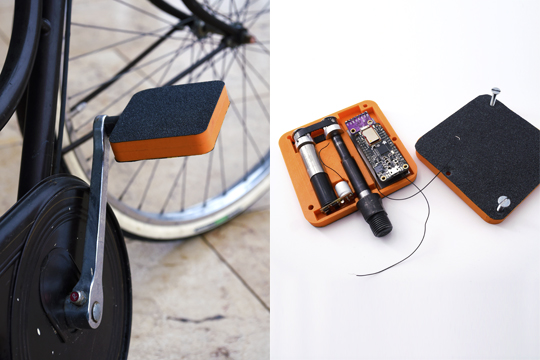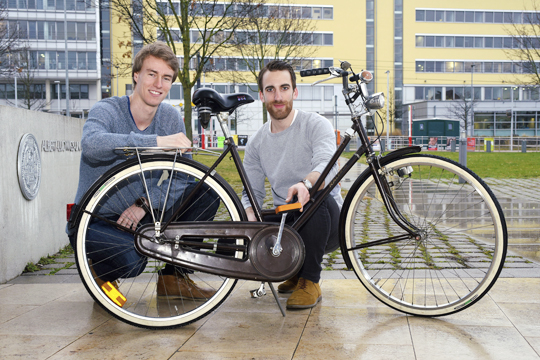Bicycle pedal for the 21st century
Freiburg, Feb 15, 2018
SmartFaraday's intelligent pedal records data such as the number of revolutions, altitude and acceleration with its sensors. Cyclists receive information about their routes, physical performance or CO2 savings compared to automobiles. In addition, the pedal sends an alarm by possible theft or emergencies.

The SmartFaraday pedal fits every kind of bike. A tiny generator is in its interior along with a circuit board with sensors that collect measurement data. Photo: Thomas Kunz
On average 900 bicycles are stolen in Germany every day. “Mine was stolen a few weeks ago,” says David Stork. The student at the Institute of Microsystems Engineering at the University of Freiburg belongs to the SmartFaraday team. The quartet is developing a power-autonomous, intelligent pedal that can do more than turn leg power into propulsion: It provides the number of revolutions, performance, environmental friendliness, jump duration, position, route, altitude profile and the like. Cyclists can view their riding data on smartphones or bike computers either in real time or after the fact. Above all, the pedal sets off an alarm if a bike thief or emergency arises. Stork’s colleague Konstantin Hoffmann says: “SmartFaraday is bringing the bike pedal into the 21st century.”
“We are currently in the process of founding a start-up,” says Stork. SmartFaraday is still a student project. During one of the classes in the microsystems engineering program, students have to create products that are both power autonomous and cost no more than 100 euros to produce. Their passion for cycling got the project rolling, the basis for which Stork later developed the idea with the smart pedal: “I continued the idea privately.” His fellow student Hoffmann was thrilled about the idea and joined him as his partner. They found further reinforcements in their circle of friends: Dominik Leclerc, who studies Embedded Systems Engineering, contributes this programming skills while economics student Ann-Kathrin Leiting offers her knowledge about finances and markets.
Leg power as the sole energy source
Pedal prototypes have already been road-tested. They have to prove that they work reliably on the bike and can handle bumpy roads. A tiny generator has been installed in its interior. Leg power is the sole energy source for the pedals. “The pedal resistance is only slightly higher,” emphasizes Hoffmann. Small cables run from the generator to a circuit board, which is equipped with sensors. These measure the pressure on the tread, the acceleration or - based on the air pressure - the geographical altitude. The data can be used to calculate values such as number of revolutions, climb performance, flight times in jumps, calorie consumption or CO2 savings compared to cars. Using a GPS, the pedal can also provide information about the current position, route, kilometers and average speed. “The basic idea is that users get to select which information they want displayed,” explains Hoffmann. The pedal should fit to every bike while the features should suit every type of cyclist.
Watchful and clever
SmartFaraday is still fine-tuning some of the features. “It is not clear how theft protection will look in detail,” says Stork. How will a bike know it is being stolen? “It notices when its owner is gone,” he explains. The owners communicate with the pedal via smartphone and Bluetooth. The signal’s strength decreases with distance. Based on that and other things, clever bikes can tell if their mistress or master is going to work on them or some brazen pickpocket. If it is the latter, an alarm goes off on the cellphone of the owner or newly former owner.
Typically, those who have had their bikes stolen are too far away to stop the thief. Only one in thirteen bikes ever return with the police’s help. SmartFaraday pedals may possibly help increase the rate of returned bikes: Using the pedals’ technology, you can trace where the bike thieves take the stolen property. “Perhaps our pedals will automatically lock the bikes the moment the owners leave?” Stork considers the option. It would be possible with electronic immobilizers. “We could also install tiny speakers,” he pursues the thought further. The smart pedal would then squeal loudly as soon as the bikes are moved without their owners being there.

Konstantin Hoffmann (left) and David Stork want to bring their technology to market soon. Photo: Thomas Kunz
Emergencies have typical movement patterns
Are we in danger of a wave of howling bikes the moment a gust of wind pushes them over? “No,” insists Hoffmann: “Our pedal can differentiate whether a bike has merely toppled over or has been moved on purpose.” All data land in the cloud for analysis first: movement patterns reveal whether a gust of wind or a thief had a hand in it. They also show when and for who long cyclists lift them. “The ground’s surface provides tiny vibrations that aren’t there during a jump, for instance.” Similarly, typical patters reveal whether a cyclist is merely taking a break or if it’s an emergency. In the latter case, emergency contacts are alerted with a message. They can call the person who has had the accident and offer precise directions for the ambulance in severe cases. The clever pedal also transmits the coordinates of the scene of the accident with a special wireless technology with a particularly long range.
“The customers alone decide which data are stored where, along with how they are analyzed or made public,” ensures Hoffmann. SmartFarady wants to hire specialists to optimize data security, analysis and infrastructure. That costs money as does the patent they wish to get for it. For these reasons, the group has applied to multiple funding programs. “When we have settled the financing and nothing unexpected arises, we want to bring the product to market by the end of 2018.”
Bike high-tech „Made in Freiburg“
The concept has been a hit for sure: At the end of 2017 SmartFaraday won both first place in a nationwide COSIMA competition for microsystem usage as well as the people’s choice award in the business plan competition Startinsland that the Founders Office at the University of Freiburg helped host and guide. “I didn’t know a thing about business plans before that,” says Stork. He and Hoffmann would have loved to have learned more about how to found a start-up during their studies. “Our lecturers didn’t really inspire us to pursue a start-up,” Hoffmann regrets to say. Perhaps they don’t have an appreciation for it: “In our field top-level students are told to enter academia at best.” On the other hand, Hoffmann and Stork sing the highest praises for the Founders Office. The University really stands behind its start-ups. Permission to skip class? No problem, they say. “They never say ‘no’ at the University.”
Lastly, Konstantin Hoffmann is dreaming of a pedal “Made in Freiburg”: “We want to purchase the individual parts we need in the city or region.” There is a lot of know-how and interest on bikes and their technology here. Environmental and climate protection are also issues here. “Our pedals can show off how much CO2 cars would have emitted on the exact same route,” says Stork. The value is intended to sensitize cyclists to climate protection in everyday life and to motivate them, hopes David Stork: “Cyclists can easily save kilos of CO2 every month.”
Jürgen Schickinge

